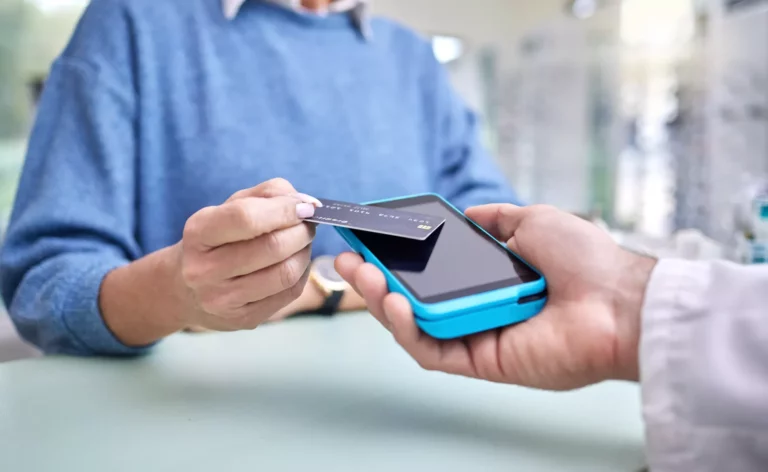Paper bills in the mail, multiple statements, and confusing user portals make healthcare bills easily ignored by patients—and healthcare payments slow, or even stalled.
But healthcare providers don’t just lose payments: manual payment touchpoints drive up administrative costs and overwhelm staff.
Ultimately, the traditional patient payment experience is complex and frustrating, and leaves revenue cycle teams spinning their wheels.
Providers need a patient payments solution that’s cost-efficient and fast—patients want the financial experience to be a breeze.
The answer? Text-to-pay.
What Is Text-to-Pay?
Text-to-pay consolidates the complex medical billing process into a few simple steps.
A mobile billing and patient payments solution, text-to-pay is driven by SMS—which usually drives users to an app or a portal to pay.
Patients just need to give providers their cell phone number, and revenue cycle teams then simply text a patient with the amount due. Patients tap the link in the text notification and pay directly from their mobile devices. And that’s it; easy, and leaves no room for confusion.
It’s convenient and clear for patients—and providers get their own set of advantages.
The Added Convenience of AccessOne’s MobilePay
With most text-to-pay solutions, when a patient taps the link in the SMS they are led to a portal or app, where they need to log in with a password.
While much simpler than traditional solutions, this method still creates some user friction—patients need to remember passwords and find their way around the portal or app.
Solutions like AccessOne’s MobilePay take text-to-pay to the next level by removing all payment barriers, with no app to download and no login required. A user taps the SMS link, pays right there, and gets an immediate notification of payment.
A payment portal can still be useful and is a great place to start, particularly for patients who are frequent visitors. Specialties like family medicine and OB/GYN who typically have a deep, ongoing relationship with their patients should leverage a portal. But what about other providers where portal usage at best might be 30-40% of their patient population? Complementing a portal with a seamless text-to-pay solution helps collect payments from many more patients.
Benefits of Text-to-Pay for Patients and Providers
Text-to-pay is a simple solution, which complements billing software while taking advantage of the technology 77% of Americans carry in their pockets.
As it’s completely automatic, text-to-pay requires minimal effort from providers and simultaneously eliminates patient confusion and friction.
In fact, it’s so quick that it can deliver payment even before providers send patients the actual bill. Take MainStreet, for example, a family practice with several locations throughout the southeast: with text-to-pay mobile payments, 95% of accounts are paid within 14 days. And more than 80% of that bucket is paid before printing a paper statement.
Even better? The accuracy is spot on. “The system integrates with our patient portal so the most accurate out-of-pocket amount is conveyed to patients,” says Drew Smith, Director of Revenue Cycle.
Removing barriers increases revenue. When making payments is effortless, our data shows that 36% of patients do so within 24 hours. With text-to-pay, revenue teams can measure accounts receivable in hours instead of months.
In addition to streamlining the payment process, text-to-pay reduces administrative costs and improves cash flow. Compiling, printing, and mailing paper statements is expensive. Not to mention staffing call centers.
Text-to-pay slashes paper costs and call volume. For instance, BestMed reduced the paper statements they sent by 19% after they deployed text-to-pay technology.
Impact of Text-to-Pay on Patient Satisfaction
While not a line item in a balance sheet, patient satisfaction is directly tied to revenue. And the patient payment experience is a big part of satisfaction.
Right now, the medical industry as a whole isn’t winning awards for a great patient payment experience, with 46% of patients reporting the healthcare industry is the hardest in which to make a payment.
If patients don’t have a great experience with care through payment, they won’t hesitate to find another provider. In fact, half of healthcare consumers state that one bad digital experience can ruin their entire experience with a provider
Today’s patients are consumers who shop for healthcare much like products on Amazon. They compare prices, examine payment options, and want a personalized experience tailored to their needs. And one of the things patients are after is digitized healthcare payments.
Text-to-pay allows providers to meet patients where they are, as well as demonstrate compassion and flexibility beyond the exam room.
When patients understand their financial obligations and find it easy to make a payment, they are more likely to do so in a much quicker manner. One director of revenue cycle management said her patients “rave” about text-to-pay mobile solutions.
Text-to-Pay vs.Traditional Patient Payment Options
The conclusion is definitive when comparing text-to-pay with traditional patient payments: text-to-pay is wildly effective.
Traditional billing methods take several rounds of back-and-forth to correct errors and address patient confusion. Mailing paper statements is expensive and time-consuming, and many are returned due to inaccurate patient data.
It’s much easier to register a phone number during the registration process, and it’s much more accurate to then send one text with payment details.
Text-to-pay is as user-friendly as it can get, as it requires next to zero effort from the patient. When contrasted with the frustrating current patient financial experience, text-to-pay is the clear winner.
To make it even more apparent, let’s break it down:
| Text-To-Pay | Traditional Billing |
| Automatic | Manual |
| User-friendly | Difficult to navigate |
| Straightforward | Confusing |
| Cost-effective | Expensive (paper, call center staffing, etc.) |
| Fast Payments | Delayed Payments |
Ready To Implement Text-to-Pay? Here’s How To Get Started
Collecting patient payments via text can dramatically and immediately impact the revenue of healthcare providers.
Implementing a text-to-pay system isn’t the huge IT undertaking you might anticipate—far from it.
To begin with, we recommend partnering with an established mobile payments provider that has a track record of success and satisfied healthcare providers.
With a reliable partner like AccessOne, you’ll get an efficient, cost-effective solution, with the added value of 24/7 customer support for your patients, so that they can solve any questions they might have.
In just around 10 weeks after signing the contract, AccessOne customers are ready to collect patient payments, without any disruption to current operations.
Our solution is designed to augment existing RCM investments, not replace them. In addition to being HIPAA, TCPA, and PCI compliant, AccessOne’s text-to-pay technology also integrates with every major medical billing and statement platform.
Speed Up Payments With Text-to-Pay
Your patients have a cell phone. Why send paper statements to their mailbox when a notification in their pocket is all it takes?
With AccessOne’s mobile payments solutions, you make it easy for your patients, and convenient for your revenue team.
Explore what text-to-pay could do for your revenue cycle—get in touch with our team at AccessOne to schedule your demo today.


